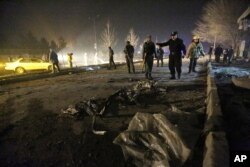The government of Afghanistan says it has adopted a new strategy to counter Islamic State, but it has not given any specific details.
The plan, approved Monday at the National Security Council weekly meeting chaired by President Ashraf Ghani, calls IS an "enemy of Afghanistan's national security."
"The counter-IS strategy was approved in principle so that all specific priorities in the fight against IS are identified," Tawab Ghorzang, the spokesperson for the Afghan National Security Council, told VOA's Afghan service.
"The Afghan government is committed in its fight against the IS group," Ghorzang said, adding that Afghan security and defense forces have been asked to organize their anti-IS policies and operations in accordance with the new strategy.
But in a nation known for unbridled lawlessness — and where Afghan troops are struggling in the fight against IS, the Taliban and other militants — the strategy seems vague, analysts say.
It's not clear what military, political and social tools would be used to combat IS, RAND Corporation military analyst Rebecca Zimmerman told VOA.
"Until the strategy is public, it will be difficult to know how specific it is," she said. "In what provinces will the campaign take place? Will it rely predominantly on Afghan military forces?"
"How will it interface with the U.S. counter-IS efforts?" she asked. "To what extent is the counter-IS plan synchronized with other efforts to combat anti-government groups, such as al-Qaida and the Taliban?"
IS footprint
IS has established a footprint in a number of districts in eastern Nangarhar province. Its fighters have launched multiple attacks on government security checkpoints. IS also has engaged in fierce clashes with rival Taliban militants in the province.
Recent Afghan and NATO cleanup operations have made it more difficult for IS to expand in the country. Many areas have been cleared of IS fighters and its capabilities have been eroded, according to government officials and analysts.
Kabul-based analyst Wahid Muzhda believes that IS has relatively small numbers in Afghanistan who influence only one part of the country compared to the broader impact of the Taliban.
"IS is not that big of a challenge. The government should prepare a strategy to combat other militant groups," Muzhda told VOA.
Afghan National Security Council spokesman Ghorzang told VOA that the government’s IS strategy will include ways political groups and Afghans can help "eradicate the IS phenomenon."
RAND's Zimmerman told VOA: "The existence of a strategy developed by the Afghan government to combat IS [is] a good step. That it appears to comprise not only military, but also political elements is a positive sign."
VOA's Mohamad Jafar contributed to this report.











